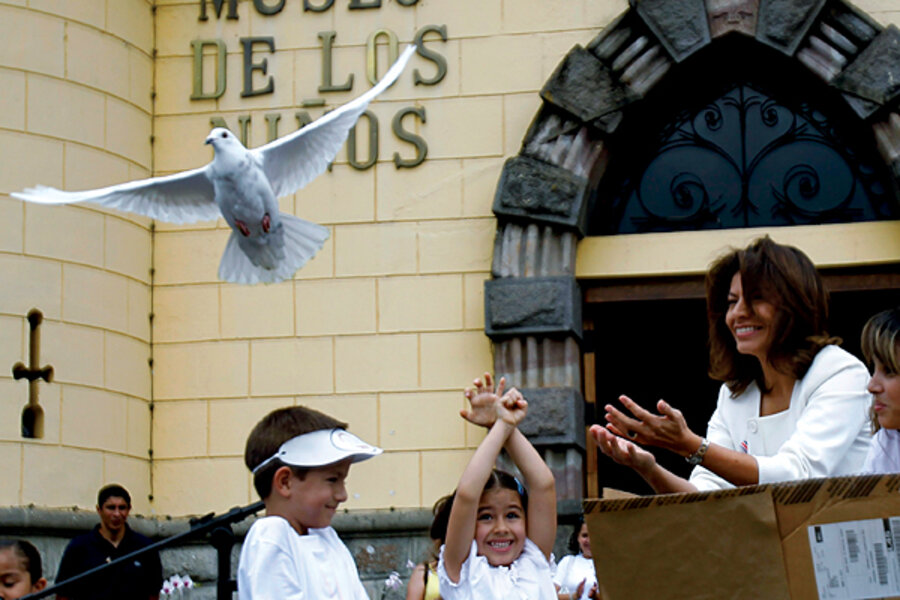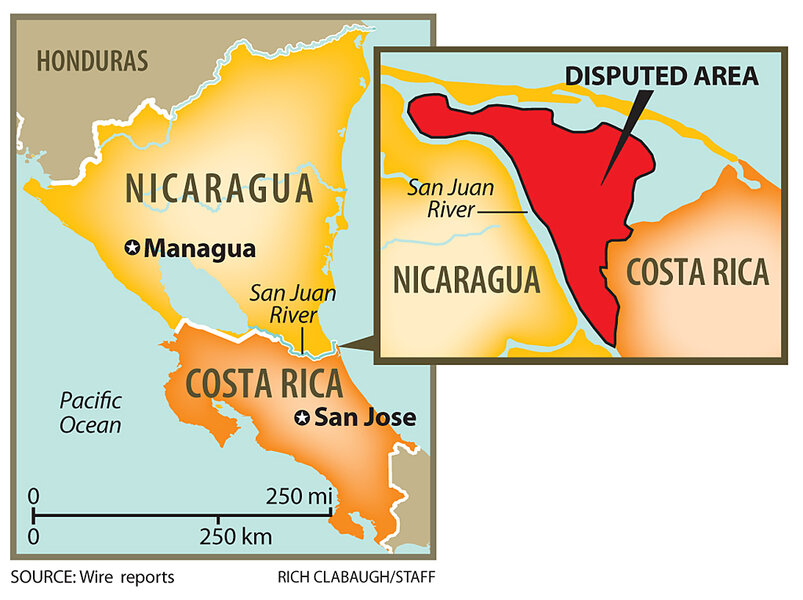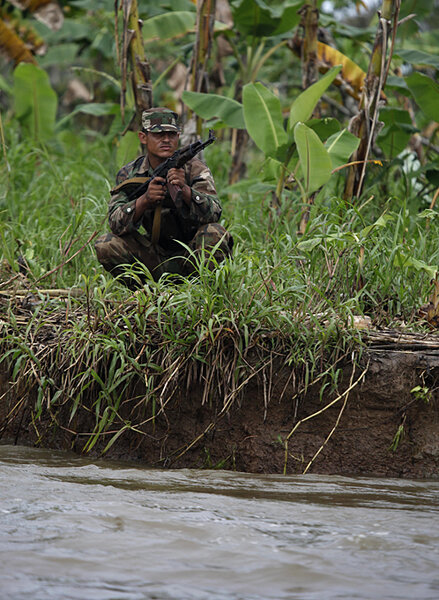Why Nicaragua and Costa Rica are in a tense standoff over a remote swamp
Loading...
| Río San Juan, Nicaragua; and Mexico City
A simmering border dispute over a remote swamp island is threatening bilateral ties between Costa Rica and Nicaragua and putting regional stability at risk.
The conflict erupted in October, when Nicaraguan President Daniel Ortega began a controversial dredging project to redirect the San Juan River – a Nicaraguan-controlled waterway that forms part of the border – farther south for "historical" accuracy. Fifty Nicaraguan troops soon followed and set up camp on a narrow stretch of disputed land near Costa Rica's Calero Island, ostensibly to combat drug trafficking.
While Costa Rica and other regional neighbors have asked Nicaragua to withdraw its troops from the area, Mr. Ortega says his soldiers are on Nicaraguan soil and accuses Costa Rica of manufacturing “disproportionate lies about invasion” in an attempt to block Nicaragua from dredging its river and reclaiming its natural resource. A Nicaraguan government white paper released this week accuses Costa Rica of being historically manipulative and dishonest aggressor nation with an expansionist goal of seeking “direct access to the Lake of Nicaragua and San Juan River."
Costa Rica claims it’s Nicaragua that has crossed the fence to usurp neighboring land. Even Google Maps was pulled into the fray when Nicaragua pointed to the Internet application as further proof that the sand-dredging mission was on Nicaraguan soil. Google modified its map, but the standoff shows no signs of abating, with Ortega using the crisis to rally his normally polarized country behind him as he seeks reelection next year despite a constitutional ban.
"With Google or without Google, we know where the border is," says former guerrilla Edén "Commander Zero" Pastora, who is leading the Sandinista government's dredging operation.
Along with putting out a capture order for Mr. Pastora's head, Costa Rica is taking Nicaragua to The Hague, with a preliminary hearing set for Jan. 11 to 13. At the hearing, the International Court of Justice will rule on Costa Rica’s demand that Nicaragua withdraw its troops from the disputed area and halt the dredging until the final border issue is resolved – a process that could take another four years.
Impact on regional ties
Nicaragua and Costa Rica are not alone regionally in butting heads over a shared border. From Chile and Bolivia to Colombia and Venezuela, many skirmishes have blemished regional kinship and affected attitudes on xenophobia, diplomatic relations, and integration between nations.
"These small situations can become much more complicated," says Michael Shifter, president of the Inter-American Dialogue in Washington. "There is the trade question, the immigration question, the connections between both societies. All of that could suffer."
Is war brewing? Not likely. David Mares, director of the Center for Iberian and Latin American Studies at the University of California, San Diego, says these disputes rarely flare up or cause regional instability, but they can cause political friction.
"If this conflict lingers, there can be economic consequences because pressure will grow to impose sanctions on Nicaragua," says former Costa Rican Vice President Kevin Casas-Zamora. "So far, xenophobic discourse has very much been outside the mainstream in Costa Rica. That will certainly change now."
Roiling on a river
Navigation rights along the San Juan River, and the border itself, have been contested since the 1850s. Ortega says he is defending the country's territorial integrity by cleaning river sediment that has blocked water flow and shifted the river mouth northward.
"Nicaragua has the right to dredge the San Juan River to recover the flow of waters that existed in 1858" when the border treaty was signed, Ortega said. He cites the coordinates of a century-old border treaty and a 2009 ruling from the International Court of Justice – the same documents Costa Rica cites for its land claims.
The Organization of American States (OAS) stepped in on Nov. 12, voting 22 to 2 in favor of a resolution calling on Nicaragua to withdraw troops. Only Nicaragua and ally Venezuela voted against the motion.
Costa Rica declared triumph, but Nicaragua dug in its heels, saying it will not withdraw troops but might withdraw from the OAS.
Translating conflict into political capital
Costa Ricans, aware of Ortega's political aims, suspect a red herring. "The majority of Costa Ricans are suspicious that this is a smoke screen by Ortega to create national unity and distract public opinion from domestic problems and issues of democratic legitimacy," says Sergio Moya, director of the University of Costa Rica's Foreign Policy Watchdog.
Nicaragua's Edén Pastora, meanwhile, claims it's Costa Rican President Laura Chinchilla who invented the conflict to distract Costa Ricans from controversial gold mining and highway projects that have drawn heated protests in recent months.
Translating conflict into political capital, for either leader, also runs the risk of prolonging the border dispute, which none want less than those living along the San Juan River.
Upriver 150 miles from the disputed area, in the town of San Carlos, life goes on as normal for residents from both sides of the river – many of mixed Costa Rican-Nicaraguan families. On a recent afternoon during the second annual Aquatic Carnival, lively chichero musicians filled the air with festive fast-tempo beats that belied the tensions downriver.
"Once all this nonsense is over," says local river-lodge owner Yaro Ch-Praslin of the border dispute, "the Rio San Juan can become a tourism destination that benefits both countries."







